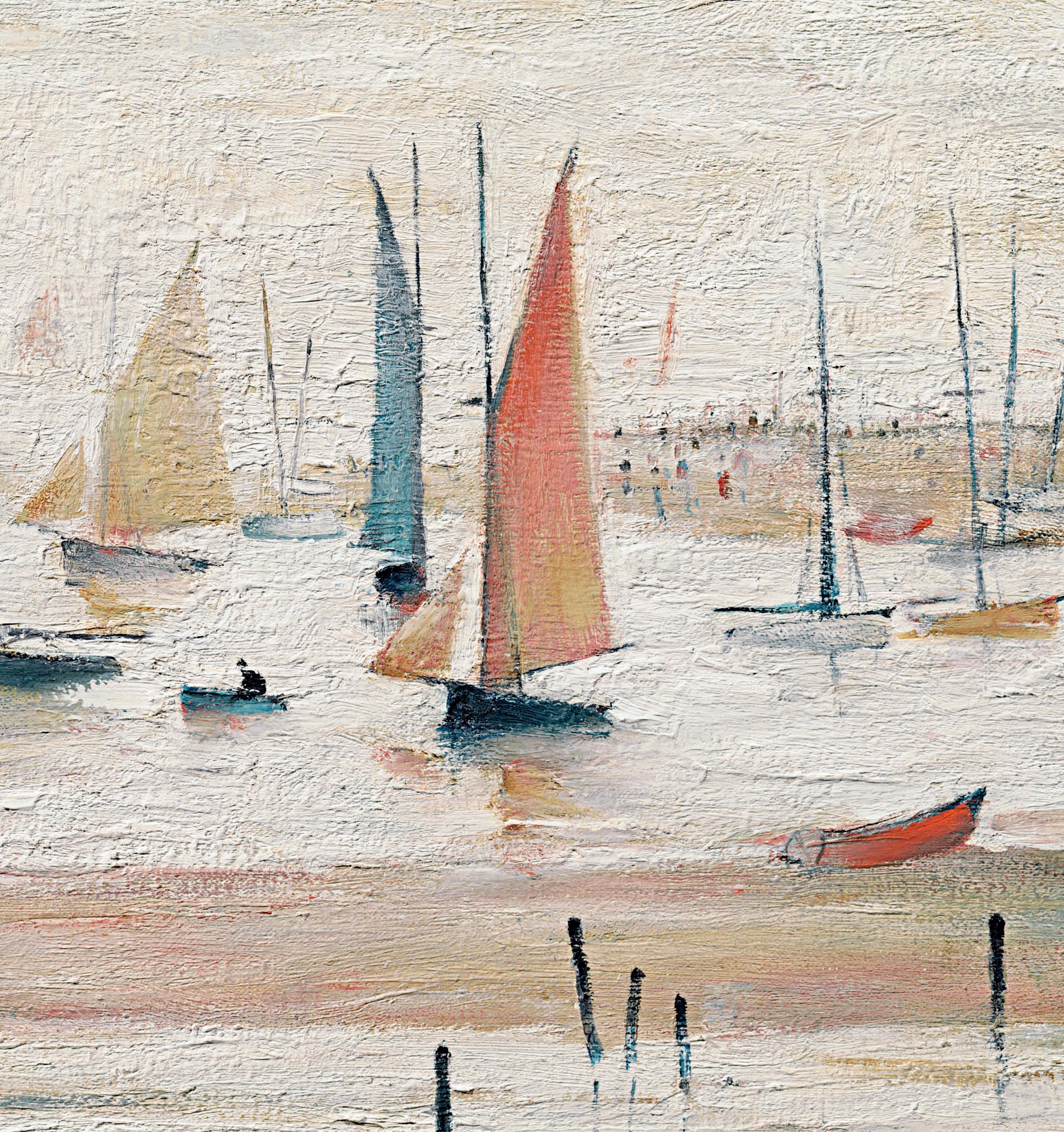1
YACHTS, LYTHAM ST ANNES
Signed and dated lower right: L.S. LOWRY 1955
Oil on canvas: 20 x 24 in / 50.8 x 61 cm
Frame size: 29 x 33 in / 73.7 x 83.8 cm
PROVENANCE:
Lefevre Gallery, London, directly from the artist [X7337];
The Rt Hon Lord Beaverbrook (1879-1964), acquired from the above in 1956;
Beaverbrook Art Gallery, Fredericton, Canada, gifted by the above in 1959 [1959.135 / 516]
EXHIBITED:
London, Lefevre Gallery, Recent Paintings by LS Lowry, MarchApril 1956, no.21
LITERATURE:
Beaverbrook Art Gallery: Paintings, University of New Brunswick, Fredericton 1959, p.51, illus. pl.61
John Hadfield (ed.), The Shell Guide to England, Michael Joseph in association with Rainbird Reference Books, London 1970, p.76, a detail illus. p.77
Lowry spent many childhood holidays with his parents at Lytham St Annes, a resort on the Lancashire coast, and began his career with images of the sea: ‘I used to draw little ships when I was eight,’ he recalled.1 Mervyn Levy suggests the yachts at Lytham St Annes in particular haunted the artist’s imagination: ‘They re-appear over the years in dreamlike evocations of those long ago holidays; a touching tribute to his mother’s love of their old holiday resort.’2 Throughout his artistic career Lowry regularly returned to the British coast for inspiration, as Richard Grossick relates, ‘observing it as a place of recreation and industry with people, promenades, promontories, docks, yachts, boats and ships. In 1938, shortly before his mother’s death, his relationship with the coastal landscape changed, stripped back to the bones, just sea and sky, a symbol of his more philosophical view of human existence.’
Lowry painted several scenes of Yachts at Lytham, marking his youthful fascination with the coast line of Lancashire and seaside locations across the country. In the present work, one of the strongest and most successful, balancing a beautiful compositional arrangement with the masterful application of predominantly white paint, Lowry includes two figures in rowing boats to the right, which also feature in his earlier painting of 1912. The painting is perhaps most comparable in style, palette and technique to Yachts at Lytham or Sailing boats, 1930, another significant picture in the oeuvre of the artist belonging to the Lowry Estate and currently on loan to Manchester City Art Gallery. This earlier picture featured in the recent film, Mrs Lowry and Son, and is believed to have been a favourite of the artist’s mother, hanging proudly on the wall of his home in Mottram until he died. The Estate collection also includes a sketch of what seems to be the same scene, which was most likely made before the motif.
2
1
The artist cited in Michael Howard, Lowry, A Visionary Artist, Lowry Press, Salford 2000, p.226.
Mervyn Levy, ‘Introduction’, LS Lowry RA 1887-1976, exh. cat., Royal Academy of Arts, London 1976, p.9.
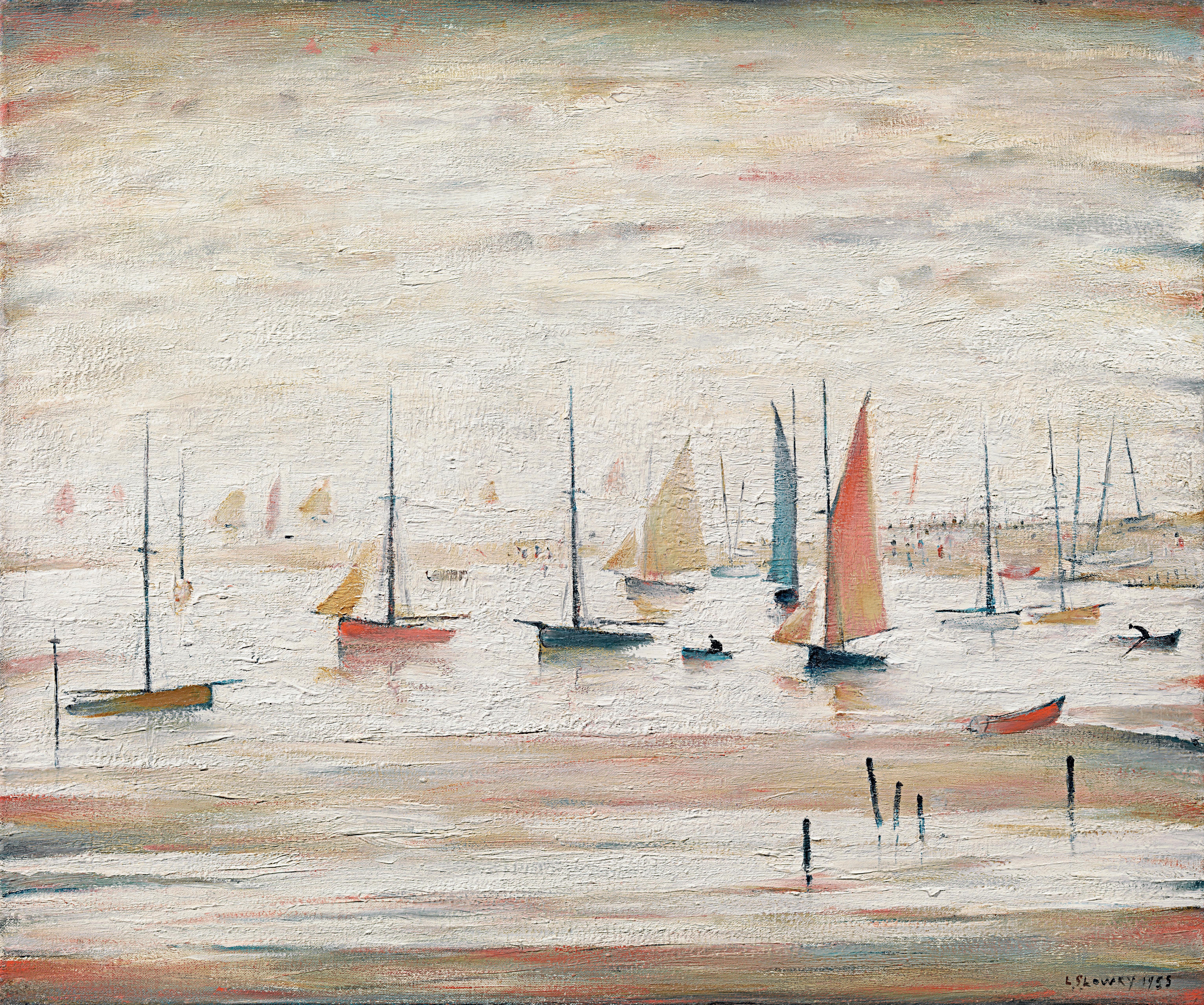
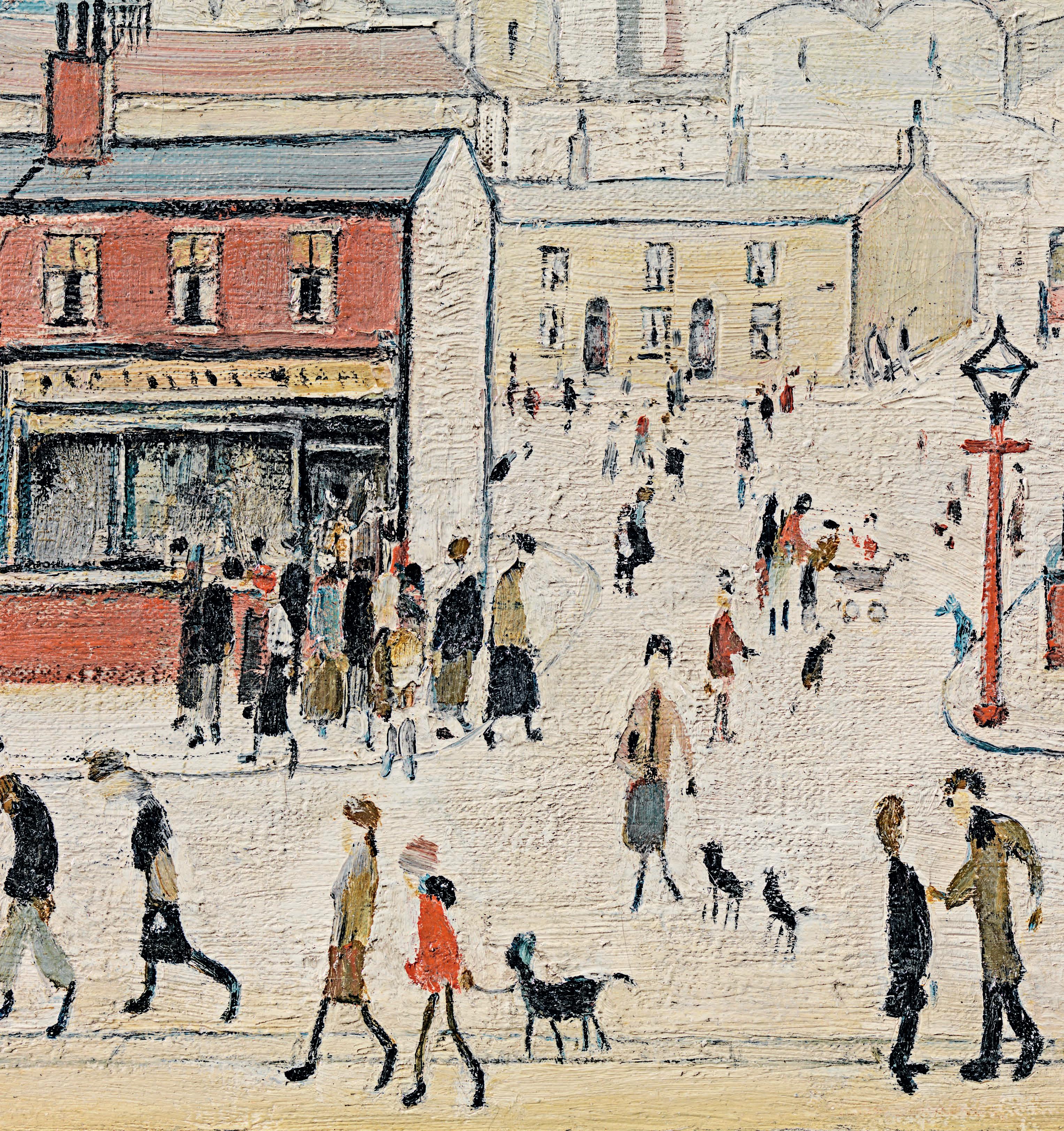
Detail: Up North (School and street with factory background), cat. no.2

2
UP NORTH
(SCHOOL AND STREET WITH FACTORY BACKGROUND)
Signed and dated lower right: LS. LOWRY . 1957
Oil on canvas: 12 x 16 in / 30.5 x 40.6 cm
Frame size: 17 ½ x 21 ½ in / 44.4 x 54.6 cm
PROVENANCE:
Howard Thomas, Esq
Sotheby’s London, 11th May 1988, lot 102; private collection
Sotheby’s London, 23rd November 1994, lot 38; Richard Green, London; private collection, 1995; Richard Green, London, 2004
Christie’s London, 10th June 2005, lot 91
MacConnal-Mason, London, 2008
Private collection
EXHIBITED:
London, Royal Academy of Arts, LS Lowry RA 1887-1976, 4th September -14th November, 1976, no 234, lent by Howard Thomas Esq
London, Richard Green, LS Lowry, A Collector’s Choice, May 2004, no.21, p.64, illus. in colour p.65
Going beyond the specifics of a locale, Lowry’s unique vision of the English industrial landscape created works which have permanently changed the way we view a street or crowd. Up North is a superb example, combining all the classic features of a Lowry urban landscape: factories with smoking chimneys, a church tower, terraced houses, a school and a central lamppost, each brought to life by the presence of the vibrant crowd. The figures in the foreground are in movement and unusually, the central pairs are interacting, face to face with gesturing arms. Beyond the foreground frieze, people head in all directions, some stopping to chat and fuss over a baby, while others queue to get into a shop. The arrangement of these groups is skilfully varied, with Lowry introducing points of colour, in vermillion, ochre and Prussian blue, to direct the viewer around the composition. We are drawn into the pale textured background of architectural silhouettes by the carriage moving up the street, the beginning of which is signposted by the red-based gas lamp.
Lowry was brought up surrounded by the giant mills, factories and terraced houses of the industrial north. In 1916, whilst waiting for a train at Pendlebury Station, Lowry found himself captivated by his surroundings for the first time. He recalled, ‘as I got to the top of the station steps I saw the Acme Spinning Company’s mill, the huge black framework of rows of yellow-lit windows stood up against the sad, damp-charged afternoon sky. The mill was turning out hundreds of little pinched, black figures, heads bent down, as though to offer the smallest surface to the swirling particles of sodden grit, were hurrying across the asphalt, along the mean streets with the inexplicable derelict gaps in the rows of houses, past the telegraph poles, homewards to high tea or pubwards, away from the mill and without a backward glance. I watched this scene - which I’d looked at many times without seeing - with rapture.’1
Lowry often referred to his later industrial scenes as ‘dreamscapes.’ His factory scenes from the late 1950s combine all the vital elements of his previous works presented in more compact form; smaller, but no less powerful, examples of his extraordinary imagination.
1
The artist cited in Judith Sandling and Michael Leber, Lowry’s City: A Painter and His Locale, Lowry Press, Salford 2000, p.17.

3
STREET IN SALFORD
Signed and dated lower left: L.S. LOWRY 1958; inscribed and dated on the stretcher and overlap: Street in Salford 58
Oil on canvas: 14 x 18 in / 35.9 x 45.7 cm
Frame size: 19 ½ x 23 ½ in / 49.5 x 59.7 cm
PROVENANCE:
Lefevre Gallery, London, 12th July 1958, directly from the artist [X7489]; private collection, 1st October 1958, acquired from the Lefevre exhibition; private collection, UK, 1992, inherited from the above
EXHIBITED:
London, Lefevre Gallery, Recent Paintings by LS Lowry, October 1958, no.27
REPRODUCED:
Photograph by Frank Martin, Lowry at work, April 1958, Hulton Archive BIPS / Getty Images
This joyful, beautifully balanced street scene is based on Francis Terrace, Salford, built in the 1850s on the east side of the River Irwell and demolished in 1959, a year after it was painted. The area was in desperate need of redevelopment in the aftermath of the Second World War and the deprivation of the local population. Before it was destroyed, Lowry was commissioned by the Curator of Salford Art Gallery, Ted Frape, to record streets in the neighbourhood of the museum.1 Richard Mayson writes, ‘the street obviously captured Lowry’s imagination, as he made a number of images of it, both drawings and an oil painting on canvas. His drawing Francis Terrace (1956) was almost certainly developed from a sketch made in situ but it illustrates Lowry’s considerable capacity for artistic licence. The scene is recognisable from contemporary photographs and the leaning, decapitated lamp standard, the railings at the end of the street and the fall of the land are all topographically accurate. However, in reality the lamppost was located just off-centre and Lowry chose to move it to the middle of the street…In the background Lowry decided to enhance the industrial setting by adding a tall mill chimney.’2
Both the drawing of 1956, in the collection of The Lowry, Salford, and the slightly larger oil painting, Francis Street, Salford, 1957 (15 ¾ x 19 ½ in), in the collection of Newport Museum & Art Gallery, feature the decapitated lamppost visible in a contemporary photograph of the street. In the present work, Lowry replaces the dilapidated post at the heart of this tight-knit community, its centrality drawing us straight into the celebratory scene in which neighbours gossip, children play and dogs often walk themselves. The cul-de-sac of twinned ‘two-up, two-down’ terraces provides a wonderful set for Lowry’s delightful human drama, with fantastic characters entering from doorways on both sides like the wings of a stage. Sir Ian McKellen, whose lifelong passion for Lowry led him to make a documentary on the artist, suggests looking at Lowry’s pictures as if they were behind a proscenium, the lines in the foreground representing the front edge of the stage.3
1 See Judith Sandling and Mike Leber, Lowry’s City. A Painter and His Locale, Lowry Press, Salford 2000, p.43.
2 Richard Mayson, Lowry’s Lamps, Unicorn, London 2020, pp.96-97.
3 See TG Rosenthal, LS Lowry: The Art and the Artist, Unicorn Press, Norwich 2010, pp.42-46.

THE FAMILY OUTING
Signed and dated lower left: L.S. LOWRY 1960
Oil on panel: 12 x 8 ½ in / 30.5 x 21.6 cm
Frame size: 18 ½ x 15 in / 47 x 38.1 cm
PROVENANCE:
Mercury Gallery, London
Private collection (Property of a Lady);
Sotheby Parke Bernet & Co., London, 16th June 1976, lot 77, as The Family of Three
Private collection, London; Richard Green, London, 2005; private collection, UK, 2006; Richard Green, London, 2017; private collection, UK
EXHIBITED:
London, The Mercury Gallery, Summer Exhibition, 1st July-26th September 1970, no.111, illus., as Family outing
London, Richard Green, LS Lowry, November 2011, no. 27, illus. in colour
Far from the weird and wonderful characters known as Lowry’s grotesques, The family outing shows a finely painted and elegantly dressed family of three, perhaps on their way to the theatre. Wearing long, dark winter coats and smart hats, the tall and slim parents stand closely together, stopping momentarily on their way. The woman’s delicate features give her a slightly haughty demeanour as she turns towards us. Though there is a large gap between them, the mother and child’s hands are very similar and seem to tentatively reach towards each other while being distracted by the same incident outside of the painting.
Towards the end of the 1950s Lowry began to paint figures standing on their own against his characteristic flake white ground. The family outing is an excellent example from this period in which figures became the principle feature of his work, showing the artist’s remarkable ability to endow his subjects with a variety of characteristics drawn entirely from experience. The luminous lead white ground, applied directly from the tube in several layers, has a mesmeric effect, rendering the painting a palimpsest of the artist’s process. Edwin Bowes writes of Lowry’s technique, ‘before he applied the second coat, he told Frank Mullineux, he might wait three months or a year and, occasionally, he might apply a third coat. Consequently, when he finally came to work on such a heavily textured surface it would feel like he was painting on rough stone. Later, however, mainly in the 1950s and 1960s, he sometimes painted on top of, or rather into, his white ground whilst it was still wet…a controlling white ambience is the unique hallmark of his developed style.’1 Bowes continues, ‘like a sculptor Lowry cut deeply into the surface carving out the forms to give them the maximum degree of uncompromising actuality.’2
2 Ibid., p.30.
1 Edwin Bowes, Painting a Lowry: Coming from the Mill: A Reconstruction by Edwin Bowes, Lowry Press, Salford 2002, p.12.
4

5
A STREET
Signed and dated lower left: L.S LOWRY 1962; signed and inscribed on the reverse: L.S Lowry / A Street Oil on panel: 10 x 8 ¾ / 27.6 x 22.2 cm
Frame size: 15 ¾ x 13 ¾ in / 40 x 34.9 cm
PROVENANCE:
Crane Kalman Gallery, London
Private collection
Christie’s London, 12th June 1987, lot 302
Private collection, UK, then by descent
EXHIBITED:
Sunderland Museum and Winter Gardens, from 1990 on loan from a private collection
LITERATURE:
Juliet Horsley, LS Lowry in the North East, Tyne & Wear Archives & Museums 2010, p.9, illus. in colour fig.9, as Street scene
As the industrial metropolis that was Manchester and Salford began to decay by the middle of the 20th century, to be replaced by new housing and industrial units, Lowry moved from the teeming street scenes that had dominated his vision through the 1920s and 1930s to concentrate on the groups of people who were born, lived and died within the confines of the city. As he commented in an interview with Gerald Cotton and Frank Mullineux, ‘the strange thing is that when the industrial scene passed out in reality, it passed out of my mind.’1 Throughout the 1950s and 60s, Lowry’s street scenes became composites of the best-loved areas of the city, recalled from his rent collecting days, celebrating the life of a tight-knit community. In the present work, a smart group of four stand together on the corner of a street, a classic Lowry figure with bowler hat, big boots and cane with three cheerful children and a smiling dog neatly framed by their urban environment. On the left, the cropped corner of a building projects into the space, its dark vertical emphasis echoed through a series of telegraph poles which lead the eye into the distance and the pale silhouettes of a church and smoking chimneys. The warm, soft palette of brown, grey, pink and cream give the scene a wonderful sense of nostalgia.
Lowry placed great importance on the relationship between architecture and the people in his paintings. During an interview Lowry once said, ‘The buildings were there and I was fascinated by the buildings. I had never seen anything like them before, but I was fascinated by the people who lived and worked in them. A country landscape is fine without people, but an industrial set without people is an empty shell. A street is not a street without people…it is as dead as mutton. It had to be a combination of the two - the mills and the people - and the composition was incidental to the people. I intend the railways, the factories, the mills to be a background…’2
1 Judith Sandling and Michael Leber, LS Lowry - The Man and his Art, City of Salford Art Gallery 1996, p.19.
2 Judith Sandling and Michael Leber, Lowry’s City: A Painter and His Locale, Lowry Press, Salford 2000, p.17.
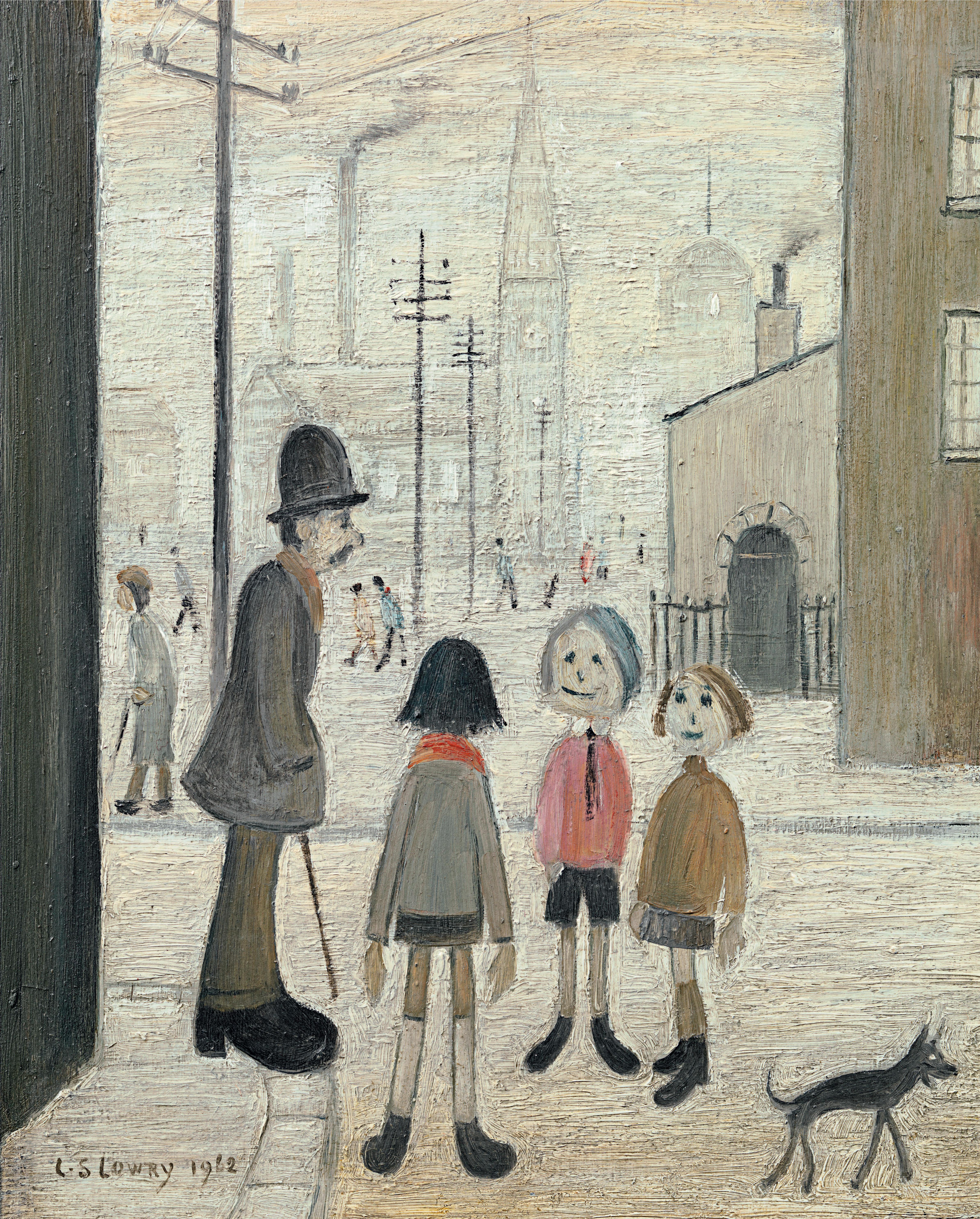
SEATED WOMAN / GIRL BY RAILINGS
Signed and dated lower left: L.S. LOWRY 1964
Oil on board: 5 ¾ x 6 ¼ in / 14.6 x 15.9 cm Frame size: 8 ¼ x 8 in / 21 x 21.9 cm
PROVENANCE: Private collection
Sotheby’s London, 19th June 1996, lot 67, as Seated woman; Richard Green, London; private collection, UK, 1997, then by descent
EXHIBITED:
London, Richard Green, LS Lowry 1887-1976, June 1997, no.10, illus. in colour, as Girl by railings Sunderland Museum and Winter Gardens, from 1997, on loan from a private collection
LITERATURE:
Juliet Horsley, LS Lowry in the North East, Tyne & Wear Archives & Museums 2010, p.59, illus. in colour fig.58, p.54
The seated woman in this unusually balanced, near-square composition, smiles peacefully out at the viewer, her hands calmly folded in her lap. The silhouette of her black costume looks slightly Victorian with full skirt, long sleeves and high, ruffled neckline. In contrast to the curved outline of the dark, upright figure, the light, outdoor setting is described with a series of vertical and horizontal lines which form a stone seat with railings beyond. This striking oil on board initially appears monochromatic but touches of ochre, like flecks of gold, are revealed beneath luscious strokes of silver bordered by bands of black and white, enlivening the surface, like the expressive application of paint.
Lowry was a solitary individual and his works often display an interest in the lonely and eccentric. The artist commented to Mervyn Levy in The Studio in March 1963, ‘I am particularly interested in down-and-outs, and misfits…in fact I’m interested in all curious people…I am not really interested in the human story behind these characters, only in what they have become, and in how their defeat and poverty has helped to isolate them, to set them apart, and give them the curious, often comical look, that interests me.’1 Lowry was a keen theatregoer and it is also possible that this striking figure relates to the Italian playwright Luigi Pirandello’s Six Characters in Search of an Author. The artist saw the play with Shelia Fell in London in 1963, who recalled that, ‘He went back to see it time and time again. Twice more with me, many times on his own. He painted the small girl in it, with her long dark hair, he painted the Six characters; he talked about it endlessly, analysing it, wondering at it. It absolutely fascinated him.’2 Pirandello’s vision ‘of a world populated by disconnected, isolated individual people, in which poignancy and bitter humour co-mingle’ undoubtedly resonated with Lowry’s imagination, but it was the visual aspect of the blackclad characters which primarily captivated the artist.3 Inspired by the actor Gill Gostling as the little girl in the play, Lowry painted Girl seen from the front and Girl seen from the back, on loan to The Lowry, Salford from the artist’s Estate, in the same year as the present work.
1 Mervyn Levy, ‘Lowry and the Lonely Ones’, The Artist at Work, 15, Studio, vol.CLXV, no.839, March 1963, p.90.
2 Shelia Fell cited in Shelley Rohde, L.S Lowry A Biography, Lowry Press, Salford 1999, p.262.
3 Michael Howard, Lowry A Visionary Artist, Lowry Press, Salford 2000, p.168.
6
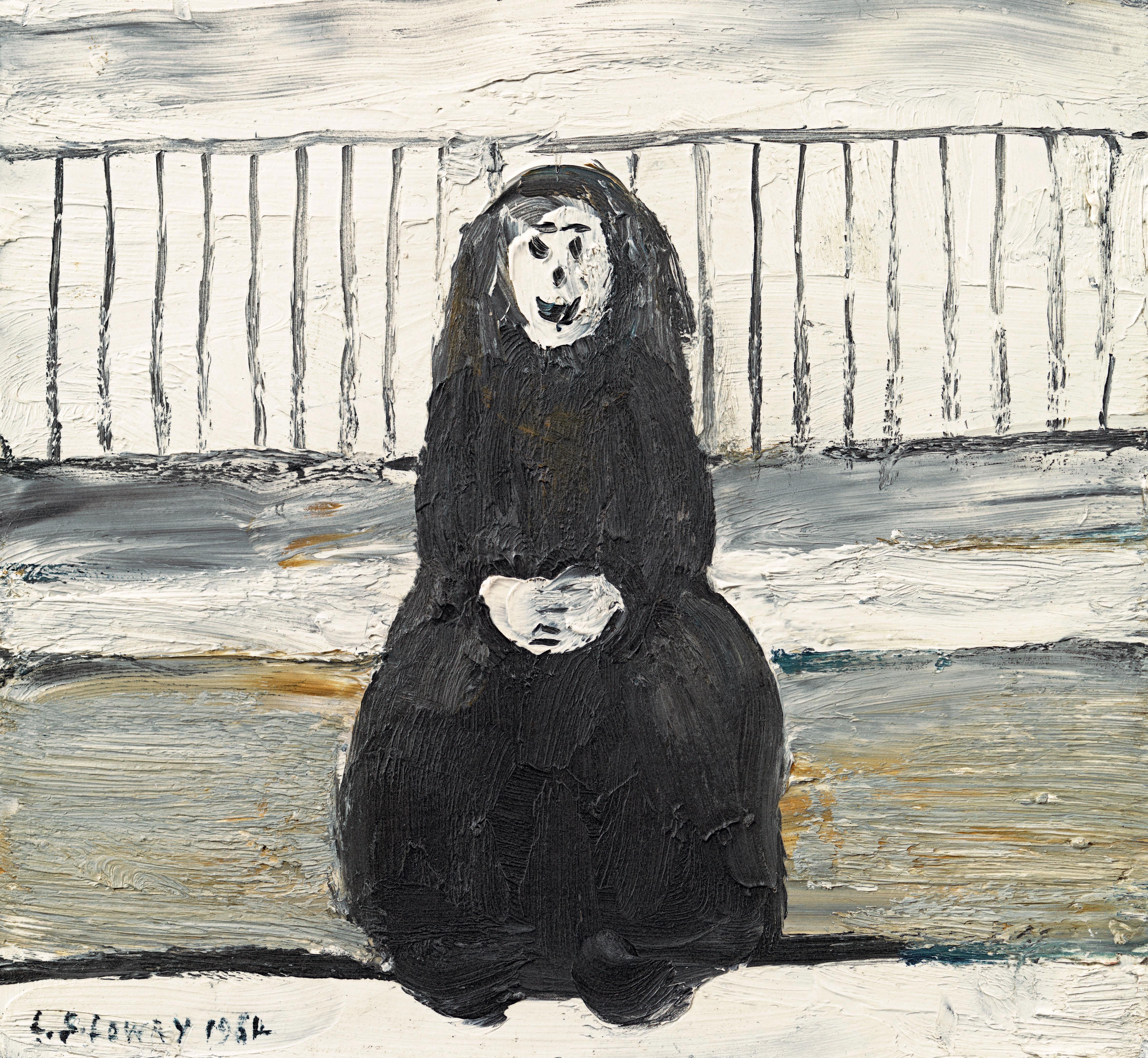
Actual size
TWO MEN TALKING
Signed and dated lower right: L.S LOWRY 1964; inscribed on the overlap: TWO MEN TALKING
Oil on canvas: 16 x 12 in / 40.6 x 30.5 cm
Frame size: 20 ½ x 16 ½ in / 52.1 x 41.9 cm
PROVENANCE:
Lefevre Gallery, London, directly from the artist [X8302]; private collection, acquired from the above, January 1975 Christie’s London, 25th November 2015, lot 31; Richard Green, London, 2015; private collection, UK
Lowry painted two works entitled Two men talking, the first in 1941 and the second twenty-three years later. At roughly the same size, both upright works feature two standing figures dressed in dark suits facing each other in an interior. The changes Lowry made more than two decades later to the figures and their setting, transform the impact of this rare and powerful painting. In the present work the two men glare at each other, their chalk white faces expressing anger and frustration echoed by the placement of their hands (previously in their pockets), the figure on the right forming a fist. In contrast to the relaxed, conversational atmosphere of the earlier painting, the figures confront each other faceto-face, their rigid poses filled with tension, repeated in the emotive background. While the light setting of the earlier work contained details of an office interior; a bookshelf, desk, door and dado rail, in the present work only the ground is defined against a striking red screen, accentuating the heated tone and intensity of the psychological exchange. The backdrop is far from flat however, its colour ranging from ochre to vermillion with white striations applied in bold, vertical strokes, its vivid fluctuation adding further drama.
Mervyn Levy suggests that many of Lowry’s figural groups are ‘studies in the problem of communication. Lowry was haunted by this idea, and once told the writer that he did not believe that, in the end, any human being could really make contact with another. His own sense of isolation led him to show his characters’ isolation even when they are apparently taking part in some joint activity. Frequently they are set in situations, and settings, which serve to emphasize this isolation.’1
Lowry enjoyed painting the interaction between pairs of figures during the 1960s, in works including My two uncles, 1962 (Laing Art Gallery, Newcastle), Two people, 1963 (The Lowry, Salford), and Two figures, 1961 (Kirklees Museums and Galleries), remarking of his later character studies, ‘I think this is my best period… I think I am saying more, going deeper into life than I did.’2
1 Mervyn Levy, The Drawings of L.S Lowry Public and Private, Jupiter Books, London 1976, no.230.
2 The artist cited in Michael Howard, Lowry: A Visionary Artist, Lowry Press, Salford 2000, p.201.
7
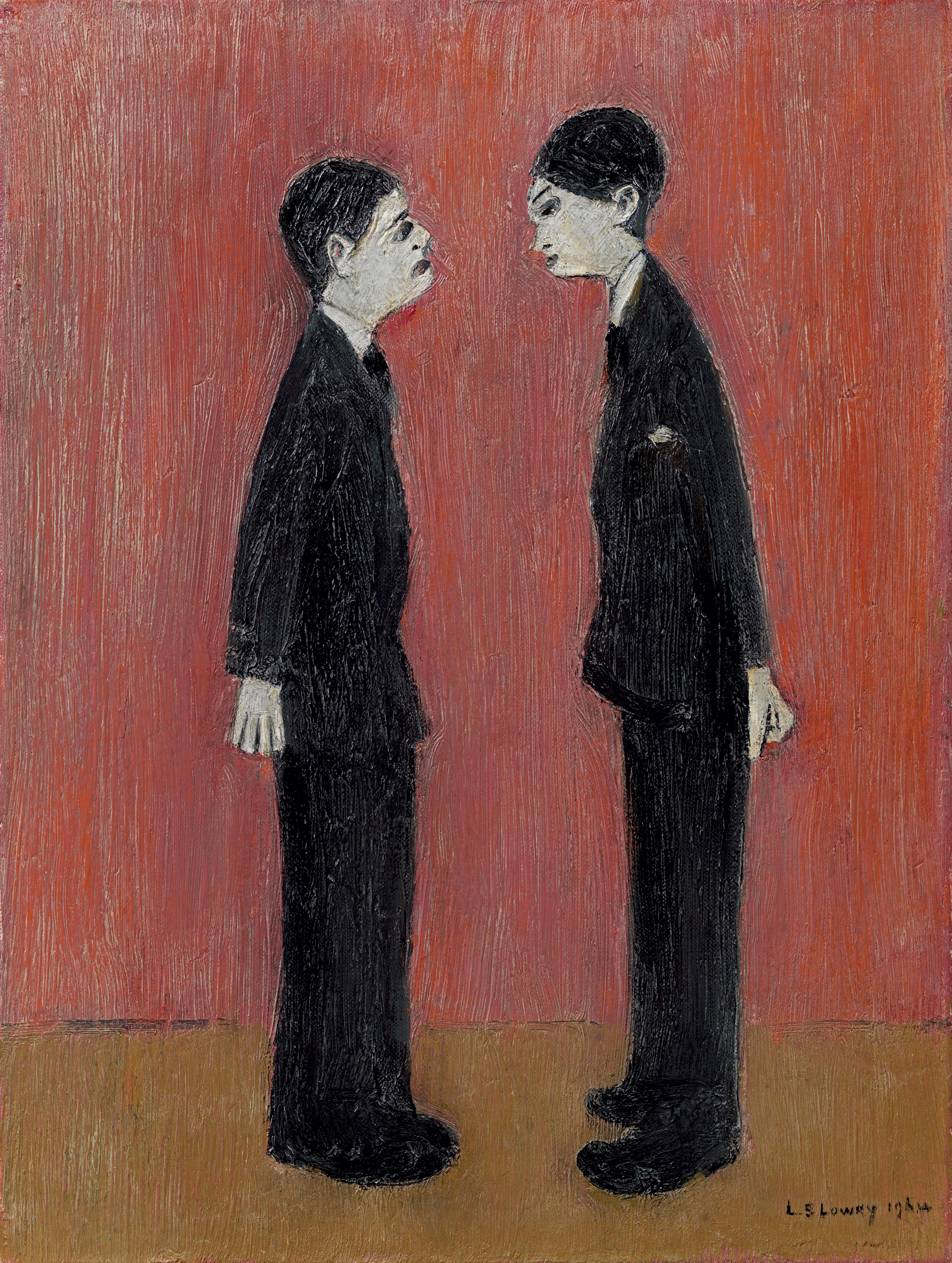
8
PROMENADE
Signed and dated lower left: LS. LOWRY 1965; inscribed on the overlap and the stretcher: PROMENADE
Oil on canvas: 12 x 10 in / 30.5 x 25.4 cm
Frame size: 15 ¾ x 13 ¾ in / 40 x 34.9 cm
PROVENANCE:
Lefevre Gallery, London, directly from the artist [X8364 & 8654]; private collection, UK, since the 1970s Christie’s London, 14th November 1986, lot 278 MacConnal-Mason, London Private collection, UK
EXHIBITED:
London, Lefevre Gallery, Paintings by LS Lowry RA, 11th May-3rd June 1967, no.34, as People on a promenade
London, Lefevre Gallery, A Memorial Exhibition of Paintings & Drawings by LS Lowry RA, 20th May-3rd July 1976, no.23, as People on a promenade, illus. p.33
Lowry’s childhood trips to the coast at Rhyll and Lytham inspired beach and promenade scenes throughout his career. In the 1960s and early ‘70s, Lowry depicted people walking or standing along a seaside esplanade, possibly based on studies he made in the North East of England at Sunderland or South Shields. As Michael Howard writes in Lowry: A Visionary Artist, ‘the figures walk and occupy themselves as they would in any of his urban scenes…the movement of the figures is counterpointed by that of the sea. His scenes celebrate the landscape of discreet holidaying, a world away from the noisy, vulgar realities of Blackpool Pleasure Beach.’1
A chance visit to Sunderland in 1960, stopping for a late lunch with friends at the Seaburn Hotel, led to a close association with the city and the hotel, which became Lowry’s base for frequent visits to the North East over the next fifteen years. Its connection to shipping and shipbuilding drew the artist, and its proximity to the sea in particular, which became increasingly important to Lowry. Juliet Horsley writes, ‘only the road and promenade separated the Seaburn Hotel from the beach, allowing Lowry to look directly out over the North Sea from his bedroom and from his table in the dining room…Lowry particularly appreciated the lack of commercial exploitation of the sea front at Roker, and thought it was one of the finest in the country. Plain and unspoilt, it had a quiet Victorian feeling that he liked, as it reminded him of the family holidays at Lytham St Annes (on the Lancashire coast) that he had enjoyed long before.’2
Several figures, including two children, gaze towards the coastline just visible beyond the railings which roughly divide this delightful canvas. Two smartly dressed women walk along the promenade in warm coats, hats and colourful scarves, one in the centre of the upright canvas, the other cropped at the ankles to the right of the foreground, drawing us directly into the scene. In contrast, two male figures stand still taking in the sea air and having a cigarette. In the middle ground two delectable dogs enjoy a neat stretch of grass.
1 Michael Howard, Lowry, A Visionary Artist, Lowry Press, Salford 2000, p.231.
2 Juliet Horsley, LS Lowry in the North East, Tyne & Wear Archives & Museums 2010, p.28.
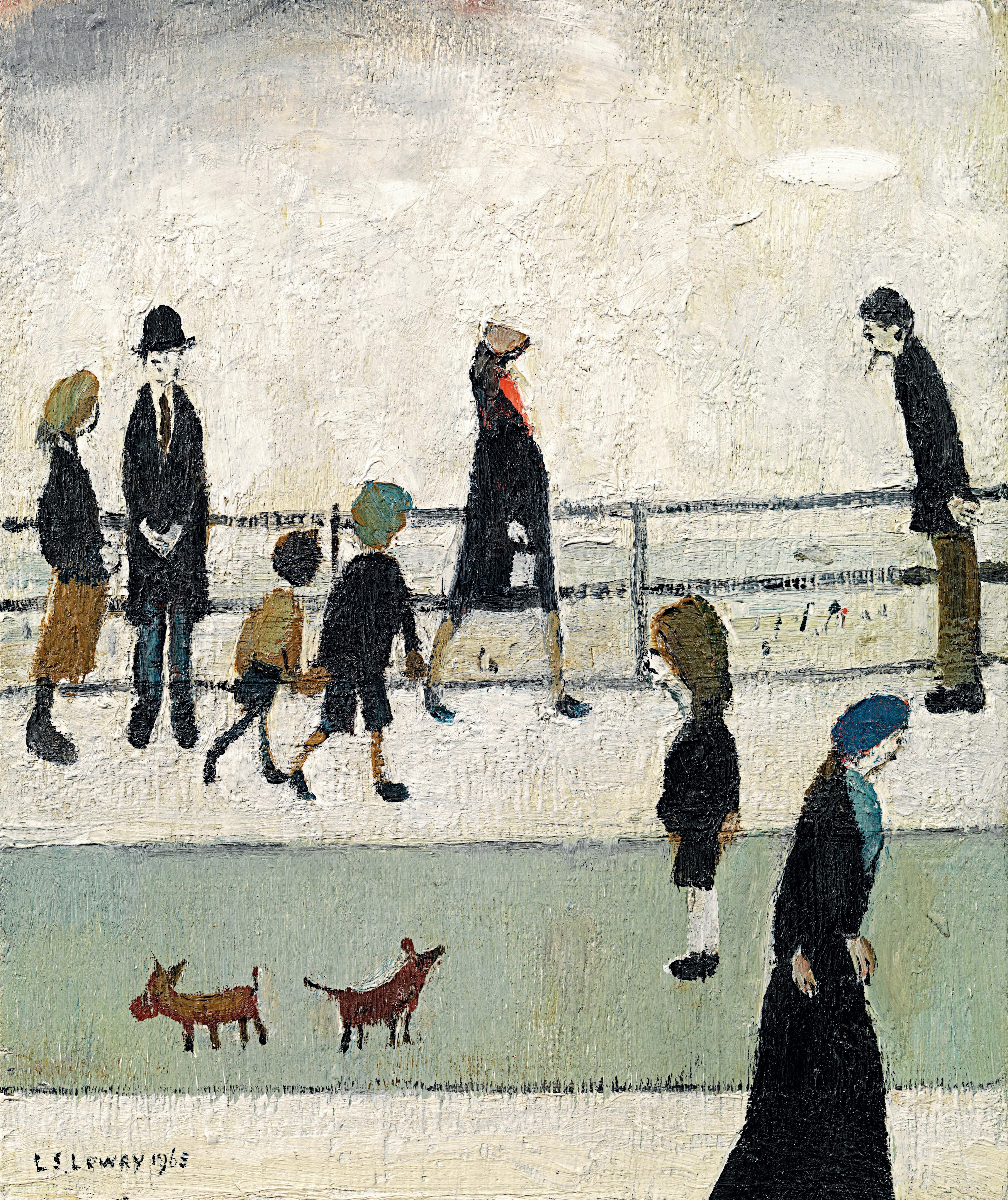
9
HEAD OF A MAN
Signed and dated lower left: L.S. LOWRY 1965; inscribed on the stretcher: 5 HEAD OF A MAN
Oil on canvas: 20 x 30 in / 50.8 x 76.2 cm
Frame size: 26 x 36 ¼ in / 66 x 92.1 cm
PROVENANCE:
Lefevre Gallery, London, 1st February 1966, directly from the artist [X8352]; private collection, 13th June 1973, acquired from the above Crane Kalman Gallery, London Sotheby’s London, 7th November 1990, lot 137; private collection, UK, acquired from the above
EXHIBITED:
London, Lefevre Gallery, Paintings by LS Lowry RA, 11th May-3rd June 1967, no.5, illus. p.6
London, Crane Kalman Gallery, LS Lowry - Heads, 26th April-3rd June 2000
A searing portrait of modern masculinity, Head of a man, 1965, is an iconic image of vulnerability and introspection. Its power lies in the directness of its representation and connection with the viewer, as well as in the honesty of its expression. The head and shoulders of the man are presented against a flowing screen of light blue pigment enhancing his penetrating gaze. Thick black lines articulate his features, given relief by more subtle grey shadows and dynamic touches of ochre and vermillion. Like many of Lowry’s figures, the man wears a large black overcoat, his sloping shoulders echoed in the curves of its deep collar. A faded red scarf crosses over his chest, drawing our attention to touches at his eyes, ears and even in his hair. Though the image’s immediate impression is stark, more sensitive detail is revealed by further contemplation; his roughly textured chin and feathery moustache. His beautiful eyes are contoured with layers of meticulous strokes following their shape with Lowry’s full spectrum of colours.
Head of a man is a panoramic return to Lowry’s male portraits of the late 1930s, such as Head of a man (with red eyes), 1938 at The Lowry, Salford, ‘one of the finest of Lowry’s imaginary portraits completed shortly before the death of his mother. The artist confessed that it was really an emotional self-portrait. ‘It was just a way of letting off steam, I suppose’, he remarked to Mervyn Levy.’1 Levy writes that Lowry’s portraits, ‘irrespective of the sitter or the sex of the subject, become synonyms of his own personal isolation and loneliness.’2 Judith Sandling, formerly Keeper of the Lowry Collection at the City of Salford Art Gallery, concurs, ‘Lowry considered these works to be somewhat emancipating as they offered an opportunity to express his moods and the resulting works are remarkably personal and honest.’3 Painted nearly thirty years later, it seems possible that Lowry, now a commercial and critical success, returned to the subject while preparing for the Arts Council retrospective of his work which toured the UK from 1966-67.
1 Michael Leber & Judith Sandling, LS Lowry, Phaidon and Salford Art Gallery, London 1987, no.278, pp.130-131.
2 Mervyn Levy, ‘Portraits’, The Paintings of LS Lowry Oils and Watercolours, Jupiter Books, London 1977, unpaginated.
3 Judith Sandling writing on Portrait of a young man, 1961, in LS Lowry, exh. cat., Richard Green, 2002, no.9, p.34.
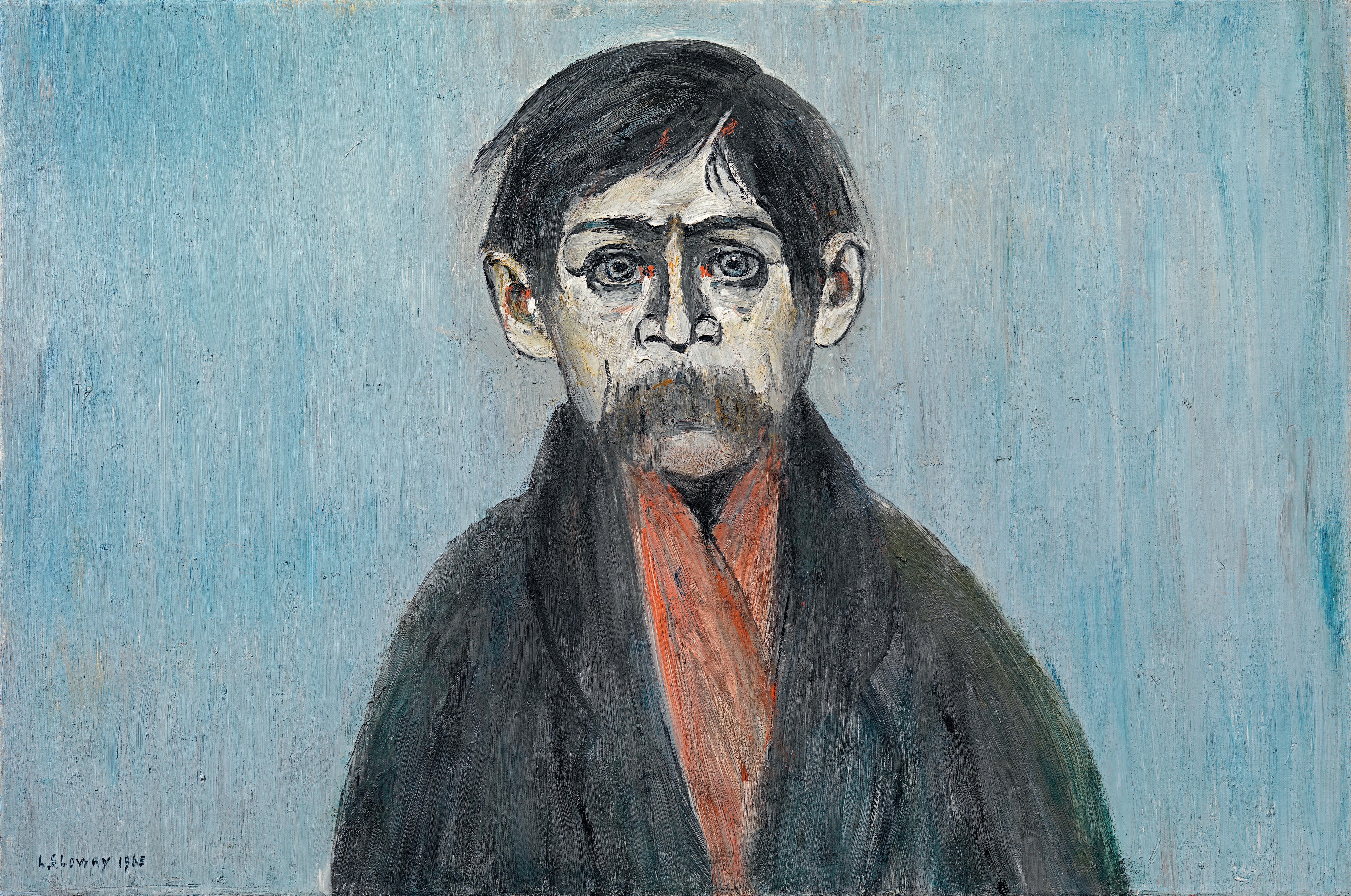
10
STUDY OF PEOPLE AND ANIMALS
Signed and dated lower left: LS LOWRY 1971
Pencil, ink, crayon and felt tip pen on paper:
8 ¾ x 11 ¼ in / 22.2 x 28.6 cm
Frame size: 17 x 19 ½ in / 43.2 x 49.5 cm
PROVENANCE:
J Davey & Sons, Manchester Private collection
Sotheby’s London, 14th March 1979, lot 116; Peter Barkworth (1929-2006), Hampstead, then by descent to David Wyn Jones (1952-2023), Folkestone, then by family descent
It seems fitting given Lowry’s love of the theatre that this dramatic work was previously owned by the Bafta-winning actor, Peter Barkworth, whose many roles on stage and screen included Where Eagles Dare, Wilde, Dr Who, The Avengers, Crown Matrimonial and Telford’s Change. Barkworth was also a great art collector and at his death bequeathed fifty-five paintings and drawings to the National Trust to be hung at Fenton House in Hampstead, including works by John Constable, Laura Knight, Walter Sickert, Duncan Grant and Paul Nash.1 The present work was inherited by his partner, David Wyn Jones, former Director of Acting at Guildhall School. On a note attached to the reverse, Barkworth wrote: ‘Its always been a favourite.’
Lowry was particularly fond of drawing in pencil often using it to produce more detailed work than is seen in his oil paintings. In his book, The Drawings of LS Lowry, Public and Private, Mervyn Levy recalls that Lowry once commented ‘Can you tell me, sir, why does a painting cost more than a drawing? After all, a drawing is every bit as important, and sometimes a damned sight more effective. Besides, it is more difficult to do; for one thing, you haven’t got colour to get you out of a mess.’2 Lowry used coloured chalks and pencils, and later ballpoint and felt tip pen, as in the present work, skilfully adding detail, depth and diversity to this fantastic group of characters. Throughout his career he employed a variety of drawing techniques and frequently used finger smudging to achieve different textures and velvety tones of black and grey, to imbue the distinctive atmosphere of the industrial north or typically English weather. His drawings are an important element of his oeuvre, grounded in the traditional drawing skills that he learnt from his teacher, Adolphe Valette (18761942). They are immediate, forceful, modern and often comic works of art. His figure drawings show the same complex of characteristics that are found in his paintings and his expressive use of pencil gives these works unique delicacy and depth of expression.
1 See Peyton Skipworth, ‘The Peter Barkworth Collection at Fenton House, Hampstead,’ The British Art Journal, Winter 2007/8, vol.8, no.3, pp.55-59.
2 The artist cited in Mervyn Levy, The Drawings of LS Lowry, Public and Private, Jupiter Books, London1976, p.13.
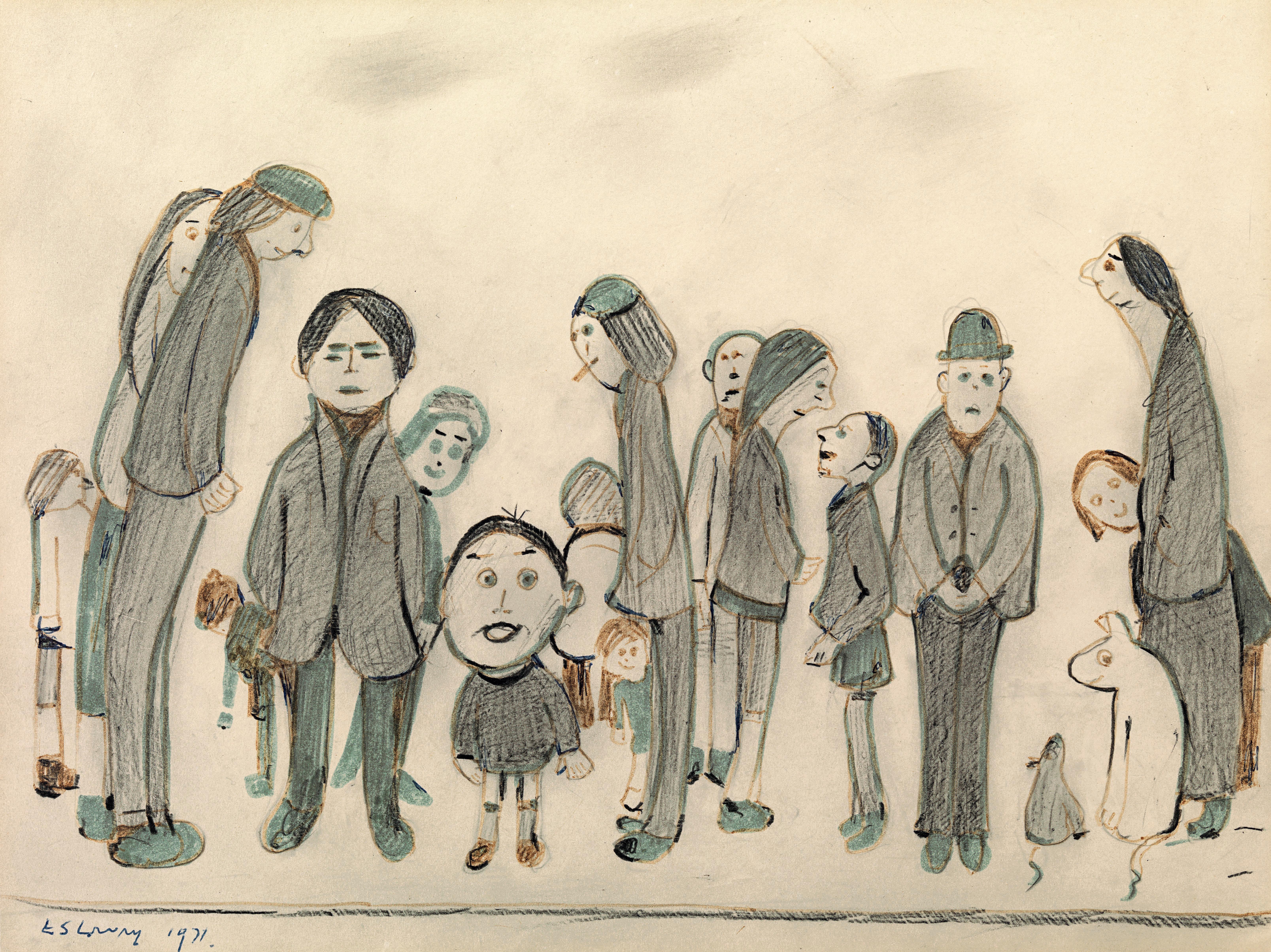
LAURENCE STEPHEN LOWRY
RA RBA LG NS
Manchester 1887 - 1976 Glossop

Sir Hugh Casson, in his preface to the 1976 Royal Academy Memorial exhibition, referred to LS Lowry as ‘one of the great English painters of this century.’ An individual artist with a unique style, Lowry’s work spans the first half of the twentieth century, recording with sensitivity and wit his own personal view of the people and architecture of the industrial north.
Born in Manchester in 1887, Laurence Stephen Lowry was the only child of Robert and Elizabeth Lowry. He started drawing at the age of eight and in 1903 began private painting classes which marked the start of a part-time education in
art that was to continue for twenty years. In 1904, aged 16, he left school and secured a job as a clerk in a chartered accountants’ firm; he remained in full-time employment until his retirement at the age of 65. His desire to be considered a serious artist led him to keep his professional and artistic life completely separate and it was not disclosed until after his death that he had worked for most of his life.
Lowry’s early training was at the Municipal College of Art, Manchester. There he was taught by the French artist Adolphe Valette who introduced him to Impressionism and
of whom he said: ‘I owe so much to him for it was he who first showed me good drawings by the great masters…he gave me the feeling that life drawing was a very wonderful thing.’ Lowry was, however, unaffected by Valette’s impressionist technique and continued to develop a more realistic approach to his art.
In 1909 Lowry and his parents moved to Pendlebury, where initially he was not happy, and for some years ignored his surroundings. In 1916, whilst waiting for a train, he became fascinated by the workers leaving the Acme Spinning Company Mill; the combination of the people and the surroundings was a revelation to him and marked the turning point in his artistic career. He now began to explore the industrial areas of South Lancashire and discovered a wealth of inspiration, remarking ‘My subjects were all around me…in those days there were mills and collieries all around Pendlebury. The people who work there were passing morning and night. All my material was on my doorstep.’
By 1920 Lowry’s street scenes, peopled with workers, housewives and children set against a backdrop of industrial buildings and terraced houses, had become central to his highly personal style. From now on he painted entirely from experience and believed that you should ‘paint the place you know.’ His leisure time was spent walking the streets of Manchester and Salford making pencil sketches on scraps of paper and the backs of used envelopes, recording anything that could be used in his work. In his early factory scenes the emphasis is placed on the buildings and the atmosphere was often dark and sombre; however, as he developed this theme the figures became more prominent and eventually he arrived at a marriage between the two where the figures and surroundings form a whole.
By the 1930s Lowry had established his own particular style. He was encouraged by his teacher Bernard Taylor to try to make his figures and buildings stand out more and he began to experiment with setting them against a white background. He chose ‘flake white,’ building up layer after layer on the canvas before painting the subject matter straight on top. He used only four other colours: vermilion, Prussian blue, ivory black and ochre, which he applied straight from the tube.
With the onset of the modernisation of the industrial north in the mid-1950s Lowry lost interest in his surroundings and now concentrated almost entirely on figures silhouetted against a white background, occasionally standing on a hint of a pavement or near a ghost of a wall, but frequently suspended in time and space. He continued to sketch and closely observe his subjects and his works from this period capture the essence of Northern people; he frequently mixes young and old and he imparts to each figure an individual character. Shelley Rohde in A Private View of LS Lowry comments: ‘he had a new obsession, his single figures, his grotesques. The struggling, surging, misshapen homunculi who used to live for so long in the shadow of the mills emerging at last from their background to stand alone, as he stood alone’.
Visits to Wales in the 1960s with his friend and patron Monty Bloom briefly revived Lowry’s interest in industrial scenes. He was impressed by the contrast between the industrial towns and the surrounding countryside; consequently his paintings from this period are brighter than his Lancashire paintings. However, towards the end of the 1960s Lowry began to lose his creative urge and, with the exception of the occasional moment of artistic inspiration, he ceased painting almost entirely.
Laurence Stephen Lowry died of pneumonia in 1976, aged 88. Although he had received critical acclaim for his work during the second half of his life, he never forgot the lack of recognition that he had received initially and he carried with him the feeling of isolation and rejection throughout his career. He refused the offer of a knighthood, as well as numerous other honours, and remained disillusioned with the art world despite the praise that was heaped upon him.
Lowry is remembered as a man of remarkable resilience and sensitivity; he stood alone, unaffected by the influences of other artists and his inspiration came entirely from his own experience. His paintings and drawings are now included in most important private and public collections in the United Kingdom and abroad and his unique works continue to receive the critical acclaim that he so richly deserves.
MUSEUMS & NATIONAL COLLECTIONS
Richard Green has assisted in the formation and development of numerous private and public collections including the following:
UNITED KINGDOM
Aberdeen: City Art Gallery
Altrincham: Dunham Massey (NT)
Barnard Castle: Bowes Museum
Bedford: Cecil Higgins Museum
Canterbury: Royal Museum and Art Gallery
Cheltenham: Art Gallery and Museum
Chester: The Grosvenor Museum
Coventry: City Museum
Dedham: Sir Alfred Munnings Art Museum
Hampshire: County Museums Service
Hull: Ferens Art Gallery
Ipswich: Borough Council Museums and Galleries
Leeds: Leeds City Art Gallery
Lincoln: Usher Gallery
Liskeard: Thorburn Museum
London: Chiswick House (English Heritage)
Department of the Environment
The Iveagh Bequest, Kenwood
The Museum of London
National Maritime Museum
National Portrait Gallery
National Postal Museum
Tate Britain
The Wimbledon Lawn Tennis Museum
Lydiard Tregoze: Lydiard House
Malmesbury: Athelstan Museum
Norwich: Castle Museum
Plymouth: City Museum and Art Gallery
Richmond: London Borough of Richmond upon Thames
and Orleans House Gallery
St Helier: States of Jersey (Office)
Southsea: Royal Marine Museum
Stirling: Stirling Smith Art Gallery and Museum
York: York City Art Gallery
AUSTRALIA
Adelaide: Art Gallery of South Australia
TERMS OF SALE
CANADA
Fredericton: Beaverbrook Art Gallery
Ottawa: The National Gallery of Canada
UNITED STATES OF AMERICA
Baltimore, MD: The Baltimore Museum of Art
Boston, MA: Museum of Fine Arts
Cincinnati, OH: Art Museum
Dayton, OH: The Dayton Art Institute
Gainesville, FL: Harn Museum of Art
Houston, TX: Sarah Campbell Blaffer Foundation
Los Angeles, CA: J Paul Getty Museum
Los Angeles County Museum of Art
New Haven, CT: Yale Center for British Art
New York, NY: Dahesh Museum
Ocala, FL: The Appleton Museum of Art
Omaha, NE: Joslyn Art Museum
Pasadena, CA: Norton Simon Museum
Rochester, NY: Genessee County Museum
San Marino, CA: The Huntington Library
St Louis, MO: Missouri Historical Society
Sharon, MA: Kendall Whaling Museum
Toledo, OH: Toledo Museum of Art
Ventura County, CA: Maritime Museum
Washington, DC: The National Gallery
The White House
Williamstown, MA: Sterling and Francine
Clark Art Institute
Winona, MN: Minnesota Marine Art Museum
Worcester, MA: Worcester Art Museum
BELGIUM
Antwerp: Maisons Rockox
Courtrai: City Art Gallery
DENMARK
Troense: Maritime Museum
IRELAND
Dublin: National Gallery of Ireland
FRANCE
Compiègne: Musée National du Château
Paris: Fondation Custodia
GERMANY
Berlin: Staatliche Kunsthalle
Darmstadt: Hessisches Landesmuseum
Hannover: Niedersachsisches
Landesmuseum
Karlsruhe: Staatliche Kunsthalle
Speyer am Rhein: Historisches Museum der Pfalz
JAPAN
Kanagawa: The Pola Museum of Art, The Pola Art Foundation
HOLLAND
Amsterdam: Joods Historisch Museum
Rijksmuseum
Amersfoort: Museum Flehite
Utrecht: Centraal Museum
SOUTH AFRICA
Durban: Art Museum
SPAIN
Madrid: Real Academia de Bellas Artes de Sun Fernando Museo Thyssen-Bornemisza
Museo Nacional del Prado
SWITZERLAND
Zurich: Schweizerisches Landesmuseum
THAILAND
Bangkok: Museum of Contemporary Art
At the time of publication all art works included in the brochure are for sale. Paintings are sold subject to our standard terms and conditions of sale Jan 2023, available on our website and upon request.
Brochure by Rachel Boyd Hall. Photography by Sophie Drury. Graphic design by Gemini Patel. Artwork © Estate of LS Lowry. All Rights Reserved, DACS 2024. Published by Richard Green. © Richard Green (and any applicable image right owners/artists or their estates) 2024. Database right maker: Richard Green. All rights reserved. Richard Green is the registered trade mark of Richard Green Master Paintings Limited registered in the EU, the USA and other countries. Printed in England by Hampton Printing (Bristol) Ltd. Event Number: 6808.
www.richardgreen.com


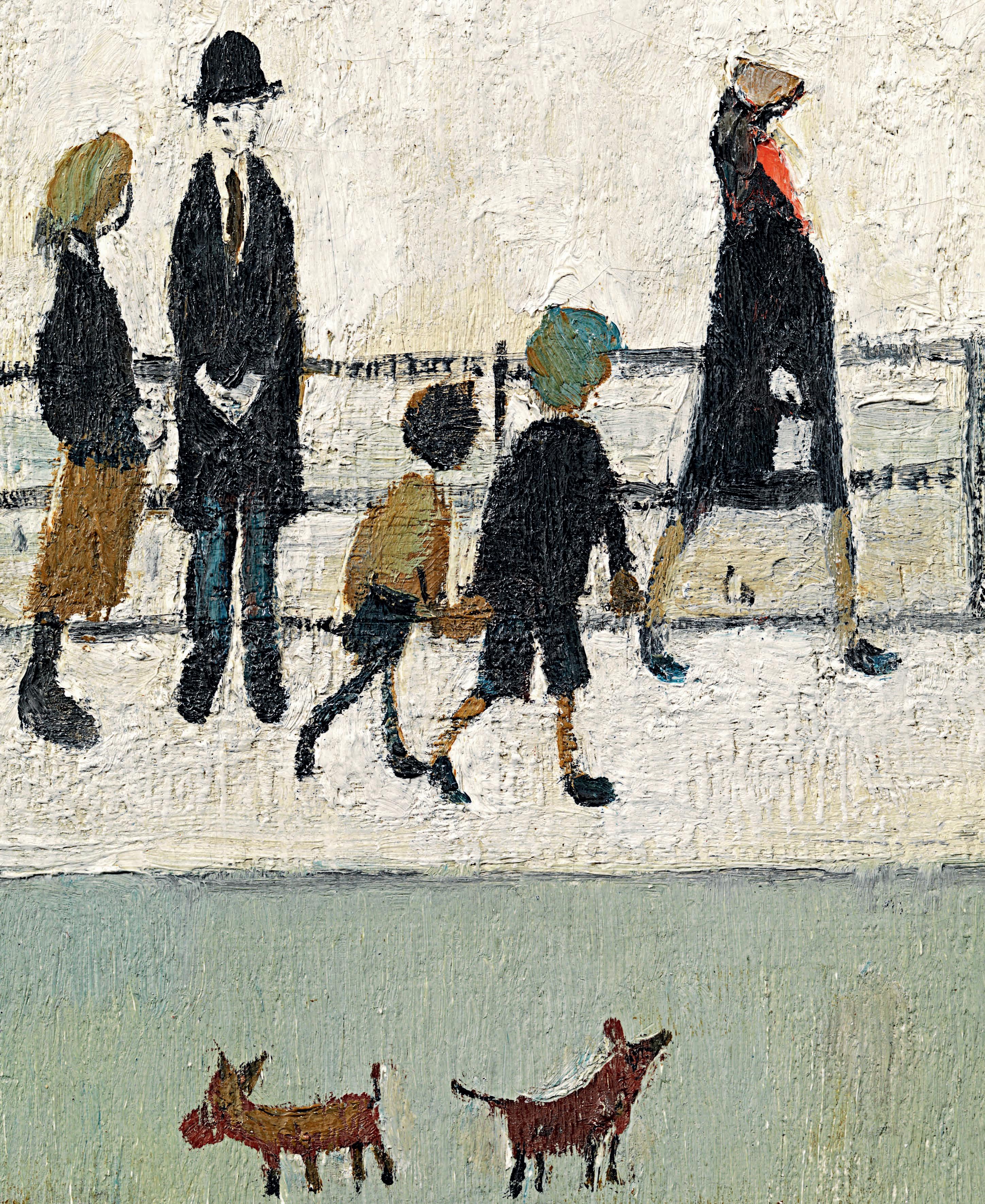


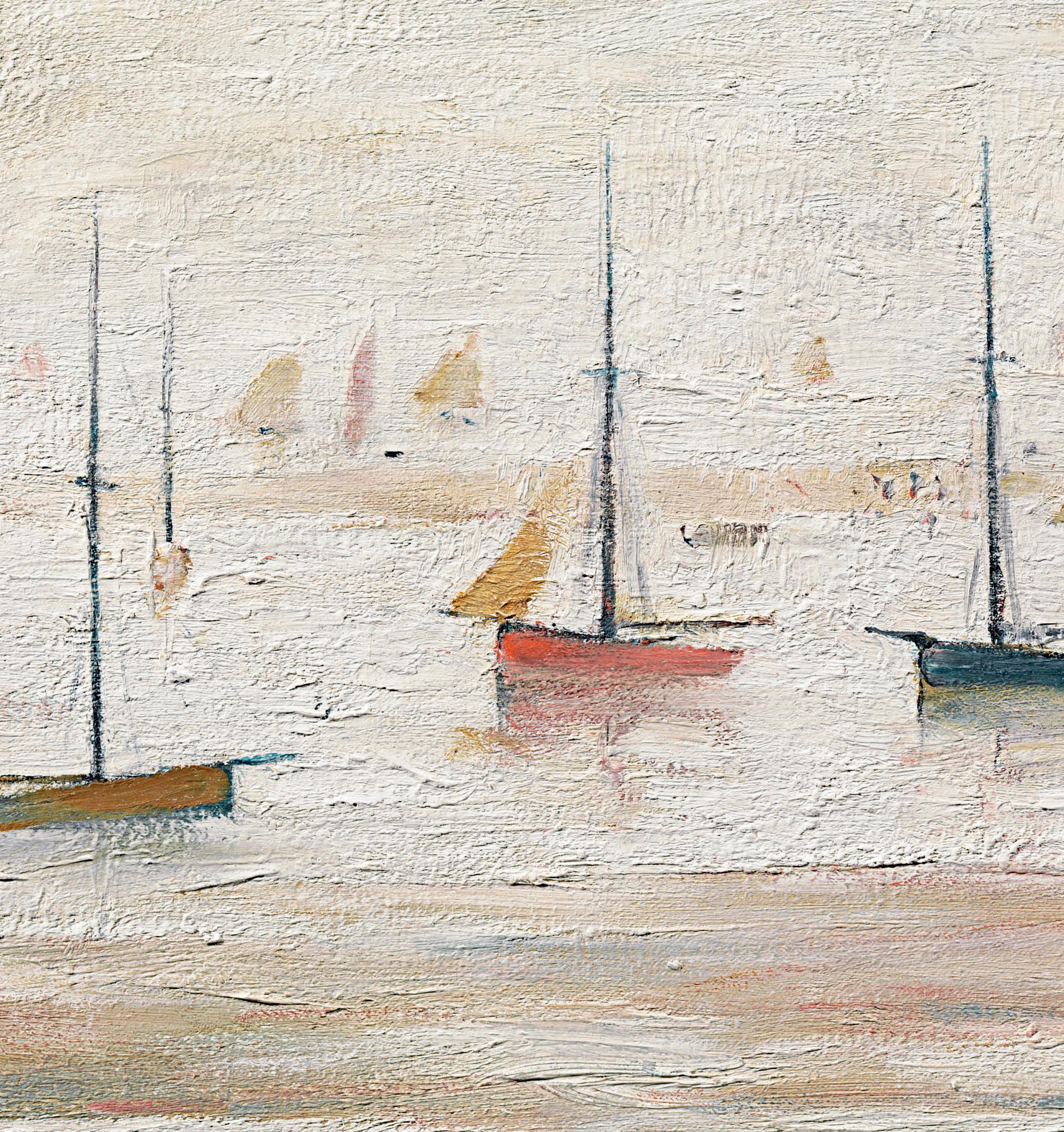 Detail: Yachts, Lytham St Annes , cat. no.1
Detail: Yachts, Lytham St Annes , cat. no.1
